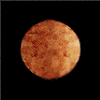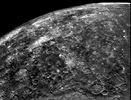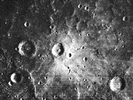
 Mercury
Mercury

Planet Profile
Mass .......................................... 3.3 X 1023 kg Diameter ........................................... 4,878 km Mean density ........................................ 5.42 gm/cm3 Escape velocity .................................... 4,300 m/sAverage distance from Sun (AU)...................... 0.387 Rotation period (length of day in Earth days)....... 58.65 Revolution period (length of year in Earth days).... 87.97
Obliquity (tilt of axis).................................0° Orbit inclination .......................................7° Orbit eccentricity (deviation from circular)........ 0.206
Mean surface temperature ............................. 452 °K Maximum surface temperature .......................... 700 °K Minimum surface temperature .......................... 100 °K
Visual geometric albedo (reflectivity)............... 0.12 Largest known surface feature............... Caloris Basin (1350 km diameter) Atmospheric components................. traces of hydrogen & helium

 Mosaic of Mercury
Mosaic of MercuryThis photomosaic of the planet Mercury was assembled from individual high-resolution images taken by Mariner 10 shortly before closest approach in 1974. The sun is shining from the right, and the terminator is at about 100 degrees west longitude. Crater Kuiper, named after astronomer Gerard P. Kuiper, can be seen just below the center of the planet's illuminated side. The landscape is dominated by large craters and basins with extensive plains between craters.
 Southwest Mercury
Southwest MercuryThe southwest quadrant of Mercury is seen in this image taken March 29, 1974, by the Mariner 10 spacecraft. The picture was taken four hours before the time of closest approach when Mariner was 198,000 km (122,760 mi) from the planet. The largest craters seen in this picture are about 100 km (62 mi) in diameter.
 Mercury Close Up
Mercury Close UpThe small, bright halo crater (center) is 10 km (6 mi) in diameter. The prominent crater further left, which has a central peak, is 30 km (19 mi) across. The darker, lightly cratered area (upper left) may be an ancient lava flow. Mercury's surface is similar to that of Earth's moon, where a history of heavy cratering is followed by volcanic filling.

This page is adapted from the Jet Propulsion Laboratory's "Welcome to the Planets" homepage.